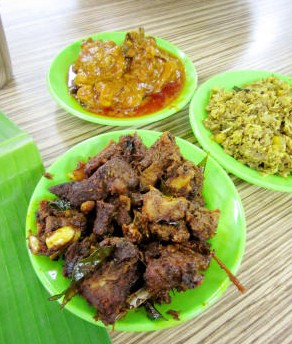Vishal Food & Catering,
15, Jalan Scott,
Off Jalan Tun Sambanthan,
Kuala Lumpur.
Tel: 03-2274 0502
This banana leaf rice has distinctive flavours and a whole load of spices.
BANANA leaf rice is typical in South Indian cuisine and comprises white rice with an assortment of vegetables, papadum and curries served on a banana leaf.
The leaf isn’t there just for aroma or presentation – the steam from the rice is said to release the coating on the banana leaf, which aids in digestion.
While it is meant to be a vegetarian dish, diners can opt to have it with a side of meat or fish. I learnt that to show your appreciation after the meal, fold the banana leaf with the edges towards you to signify that the food was good. If you fold it away from you, it implies that you didn’t find the meal satisfying.
As I stood outside Vishal Food & Catering looking slightly unsure if the place was still opened at 3.30pm, the man inside asked, “Would you like to come in? Are you here to eat banana leaf rice?”
I nodded my head and walked inside to find the mess-hall arrangement pretty interesting – there were long rows of tables, as in a cafeteria.
“Sit anywhere you like. Is this your first time here?” the man asked. When I admitted that it was, he invited me to take a look at the selection of items available at the food counter.
Vishal is a Chettinad restaurant and serves spicy, authentic dishes from Tamil Nadu. He recommended the stir-fried banana flower, something I had never tried before. I also got a plate of Mutton Varuval and Chicken Perattal to go with my banana leaf rice (RM5).
At Vishal, you get an option of white rice or unpolished rice. The latter is ideal for people who are health-conscious or need to watch their sugar intake. My dining companion decided to indulge in the white rice while I stuck to good old unpolished rice. I have a bad habit of drenching my banana leaf rice with chicken curry, but the unpolished rice didn’t get soggy.
The chicken curry gravy was SPICY. Not that that was a bad thing. I liked the level of spiciness, but those who can’t take spicy food should beware. A chilli-eater like me turned pink in the face after a few spoonfuls.
The mutton varuval (RM6) – dry-fried mutton cubes in chilli and spices – was tasty. This dish was rather spicy in a good way and the mutton was tender with a tasty layer of fat. The chicken perattal (RM4.50) tasted quite similar to the mutton varuval in terms of spices. It was decent, but I liked the mutton better.
The stir-fried banana flower (RM3) had a touch of creaminess, which I suspected came from coconut milk or desiccated coconut. This was mildly spiced and a tad oily but we both found it interesting.
Vishal serves a type of savoury onion yoghurt drink (RM2) that I enjoyed. The yoghurt is made in-house and the onions give it a touch of sweetness.
A while later, the man placed a metal cup of spicy soup in front of me. “Chicken rasam,” he said. This was the first time I had tried chicken rasam, and I found it quite delicious. It was different to the diluted, overly sour rasam I’ve been getting at other banana leaf rice places – Vishal’s version was thick and flavourful with a nice balance of sourness, pepper and spices. It made the banana leaf rice meal complete, I felt.
The food at Vishal wasn’t mind-blowing, but it tasted home-cooked and was hearty in every way. I didn’t feel thirsty after my meal, so I’m guessing little or no MSG was used. It could have been our luck that afternoon or because the restaurant wasn’t packed, but service was friendly throughout. I liked how the man took his time to explain things to me.
Our meal came up to RM27 – cheaper than what you would pay in Bangsar or PJ. While I can get banana leaf rice just five minutes’ away from where I live, I would rather brave the Brickfields traffic and make my way to Vishal for the better food and service.
Tiong Sue Lynn blogs at bangsarbabe.com and tweets at twitter.com/bangsarbabe.


